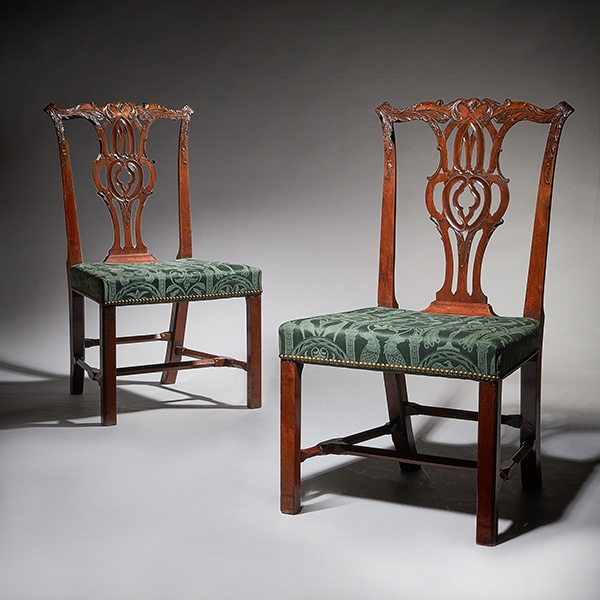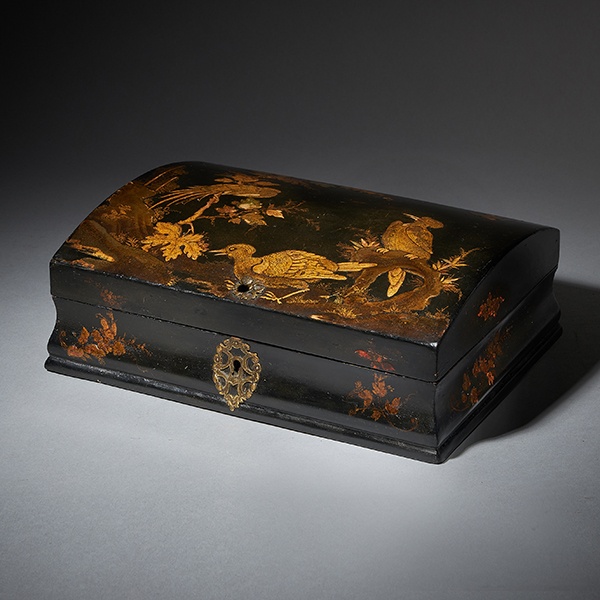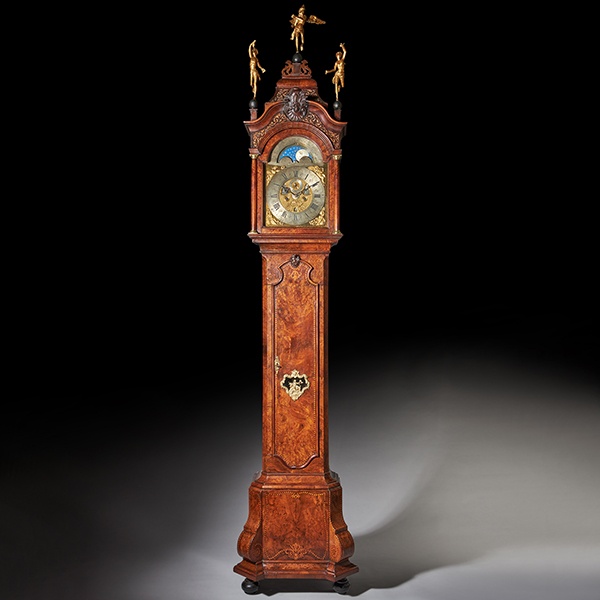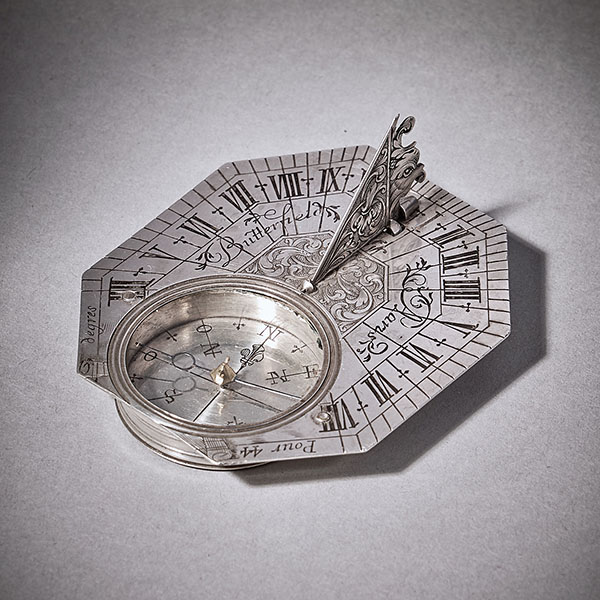17th Century William and Mary Eight Day Burr Walnut Longcase Clock, John Martin
Sold
Request Information
Follow Us
17th Century William and Mary Eight Day Burr Walnut Longcase Clock, John Martin
The attractive burr walnut-veneered oak case is of classic design for the period and has a warm patina. The formerly rising hood has a shallow caddy, lovely blind fretwork in the frieze, is flanked by plain brass-capped columns and has glazed movement viewing windows to the sides. It is surmounted by three giltwood ball finials. The case has a long trunk door framed by D-mouldings and a rectangular base resting on bun feet. There is an oval lenticle with moulded surround to the trunk door.
The weight-driven eight-day four-pillar movement has going and striking trains. The going train has anchor escapement with a royal pendulum whilst the striking train is regulated by an internal count wheel and sounds the hours on a bell. The 11-inch brass dial has a silvered chapter ring, seconds ring and date aperture in the matted centre and is embellished in the corners by elaborately pierced cherub-head spandrels. It is signed along the bottom John Martin Londini. The time is indicated by a fine pair of blued-steel hands, the hour hand richly pierced.
The maker – John Martin (1659-1709) was apprenticed to well-known maker Joseph Norris, but was transferred to his elder brother Edward not long after, probably because Joseph emigrated to The Netherlands around this time, where he is said to have introduced the longcase clock. In 1681 John Martin is recorded to have been established in Whitegate Alley between Bishopsgate Street and Spitalfield. He took quite a number of apprentices during his career as a clockmaker, the most famous one Edward Brookes. Bracket, longcase and lantern clocks, as well as watches are known by his hand.
Condition
Good. Wear consistent with age and use. The case has been conserved and the movement has been serviced and cleaned.
Dimensions
Height: 87 in. (220.98 cm)
Width: 16.5 in. (41.91 cm)
Depth: 9 in. (22.86 cm)
PREVIOUSLY SOLD
No Results Found
The page you requested could not be found. Try refining your search, or use the navigation above to locate the post.
No Results Found
The page you requested could not be found. Try refining your search, or use the navigation above to locate the post.
YOU MAY ALSO LIKE

Pair of 18th Century George III Carved Mahogany Chippendale Chairs
Pair of 18th Century George III Carved Mahogany Chippendale Chairs £8,900Follow UsPair of 18th Century George III Carved Mahogany Chippendale Chairs A simply superb pair of carved George III mahogany chairs, C.1770. Condition Good. Wear...

18th Century Japanned Chinoiserie Dome-Topped Box, Circa 1715-1725
18th Century Japanned Chinoiserie Dome-Topped Box, Circa 1715-1725 £3,800Follow Us18th Century Japanned Chinoiserie Dome-Topped Box, Circa 1715-1725 Early 18th century George I Japanned Chinoiserie dome-topped box, Circa 1715-1725. England or...

Magnificent 18th Century Striking Dutch Amsterdam Burl Walnut Longcase Clock
Magnificent 18th Century Striking Dutch Amsterdam Burl Walnut Longcase Clock £26,000Follow UsMagnificent 18th Century Striking Dutch Amsterdam Burl Walnut Longcase Clock An impressive Dutch longcase clock with a burr walnut veneered oak case,...

18th Century George III Mahogany Wine Cooler or Cellarette
18th Century George III Mahogany Wine Cooler or Cellarette £4,600Follow Us18th Century George III Mahogany Wine Cooler or Cellarette A fine and well-figured George III mahogany hexagonal wine cooler or cellarette on the original stand, C....

Striking 19th Century Carriage Clock with a Gilt-Brass Corniche Case by Grohé
Striking 19th Century Carriage Clock with a Gilt-Brass Corniche Case by Grohé £3,995 Follow UsStriking 19th Century Carriage Clock with a Gilt-Brass Corniche Case by Grohé Striking carriage clock with a gilt-brass corniche case by Grohé,...

Rare Silver Pocket Sundial and Compass by Michael Butterfield, Paris, circa 1700
Rare Silver Pocket Sundial and Compass by Michael Butterfield, Paris, circa 1700 £4,900 Follow UsRare Silver Pocket Sundial and Compass by Michael Butterfield, Paris, circa 1700 A beautiful, rare solid silver Anglo-French octagonal pocket...

Pair of 18th Century George III Carved Mahogany Chippendale Chairs
Pair of 18th Century George III Carved Mahogany Chippendale Chairs £8,900Follow UsPair of 18th Century George III Carved Mahogany Chippendale Chairs A simply superb pair of carved George III mahogany chairs, C.1770. Condition Good. Wear...

18th Century Japanned Chinoiserie Dome-Topped Box, Circa 1715-1725
18th Century Japanned Chinoiserie Dome-Topped Box, Circa 1715-1725 £3,800Follow Us18th Century Japanned Chinoiserie Dome-Topped Box, Circa 1715-1725 Early 18th century George I Japanned Chinoiserie dome-topped box, Circa 1715-1725. England or...

Magnificent 18th Century Striking Dutch Amsterdam Burl Walnut Longcase Clock
Magnificent 18th Century Striking Dutch Amsterdam Burl Walnut Longcase Clock £26,000Follow UsMagnificent 18th Century Striking Dutch Amsterdam Burl Walnut Longcase Clock An impressive Dutch longcase clock with a burr walnut veneered oak case,...

18th Century George III Mahogany Wine Cooler or Cellarette
18th Century George III Mahogany Wine Cooler or Cellarette £4,600Follow Us18th Century George III Mahogany Wine Cooler or Cellarette A fine and well-figured George III mahogany hexagonal wine cooler or cellarette on the original stand, C....

Striking 19th Century Carriage Clock with a Gilt-Brass Corniche Case by Grohé
Striking 19th Century Carriage Clock with a Gilt-Brass Corniche Case by Grohé £3,995 Follow UsStriking 19th Century Carriage Clock with a Gilt-Brass Corniche Case by Grohé Striking carriage clock with a gilt-brass corniche case by Grohé,...

Rare Silver Pocket Sundial and Compass by Michael Butterfield, Paris, circa 1700
Rare Silver Pocket Sundial and Compass by Michael Butterfield, Paris, circa 1700 £4,900 Follow UsRare Silver Pocket Sundial and Compass by Michael Butterfield, Paris, circa 1700 A beautiful, rare solid silver Anglo-French octagonal pocket...









